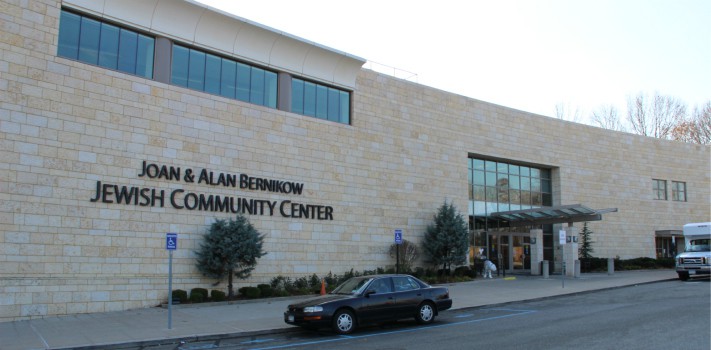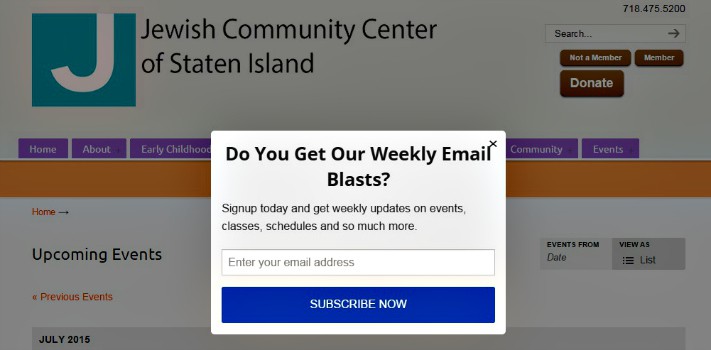Initially we started the conversation about dollars and cents. But as we were seeing the results, we also saw that this project aligned with our values as an institution, as Jews, tasked with being shepherds of the earth.
Story
Yes, we live in a digital age. If you have not yet transitioned to electronic communications and saved thousands of dollars annually in the process, here is an example of how one JCC accomplished the task.
Greening seeps into every aspect of life at the JCC of Staten Island. The roof glistens with solar panels. Green products line supply closet shelves. Motion activated lights illuminate the hallways and remarkably little paper enters or exits the building.
Bu things were not always this way.
The story of greening at the JCC begins when the JCC joined the Jewish Greening Fellowship program (which was the first iteration of the Hazon Seal of Sustainability) and JR Rich, who was appointed the JCC’s Greening Fellow, began searching the building for opportunities to save energy and reduce waste.
As the Assistant Director of Marketing, JR works closely with promotional materials every day. He knew that the JCC was using huge amounts of paper at a tremendous cost; every JCC member received four printed program guides and ten news bulletins each year.
Determined to lower that number, JR and the Green Team devised a paper reduction plan that would save a lot of paper – and money.
Since 2009, the JCC of Staten Island has drastically reduced paper usage, saving $45,000 annually, engaging community members, and enhancing Jewish life.
Here is how the JCC of Staten Island did it:
The Green Team made a plan to begin phasing out paper materials and substituting them with electronic notices. The Green Team decided to implement its plan step by step and evaluate the results:
- The Green Team collected members’ email addresses so that e-blasts could replace paper newsletters.
- the JCC cut back from four program catalogs per year to one and began only mailing the catalogs upon request.
- The JCC cut the number of news bulletins from ten to five per year. Over time, the number printed was reduced from 2,000 to 200, which are printed only as needed and only distributed in the building.
- Based on the success of the previous measures, the JCC eliminated all printed mailings. in June 2010, postcards were mailed to every member announcing that in September the JCC would begin communicating by email only. Today, the JCC’s email reach 4,000 households a week.
Some JCC staff worried that eliminating print materials would decrease participation in events, but to their surprise, there was no drop in program registrations. In fact, switching to electronic communication increased participation in some programs.
The JCC’s commitment to paper reduction has spread beyond the marketing department. For example, the preschool introduced “Activit-e,” an interactive website for parents of children. The online portal cut 90% of the paper used to communicate with parents and actually increased enrollment in preschool programs.
Reducing paper waste not only helped the JCC’s bottom line, but it also strengthened its brand. In its annual report for donors, the JCC promotes its role as a steward of the plant and a steward of donations, pledging to careful not to waste the earth’s resources – or the donors’ money.
It’s difficult to eliminate paper completely. Make sure that your institution has a working recycling program and clearly labels all recycling bins. Be sure to also remind staff what products are allowed in the recycling.
JR has simple advice for staff or laypeople trying to cut their organization’s paper use: “Don’t be afraid to advocate for change.” Convincing senior staff to take action may be difficult, but once you’ve begun, the benefits of paper reduction will speak for themselves.
“Initially we started the conversation about dollars and cents,” JR said, “but as were seeing the results, we also saw that this project aligned with our values as an institution, as Jews, tasked with being shepherds of the earth.”
Here are a few more tips for reducing paper waste at your institution:
- Think creatively – look for every opportunity to switch to electronic communication
- Have staff use smaller margins
- Print double sided
- Utilize paper scraps in art projects for youth programs
- Printing is difficult to avoid entirely, so when you do print, use recycled paper
Reducing paper waste can be the pivotal first step towards greening your institution. You’ll save trees, save money, and serve your community!
Jewish Values
When we use paper, we are using trees. Trees are the lungs of the plant. They give us oxygen and trap carbon dioxide that would otherwise overload our atmosphere and contribute to climate change. They provide us with food, wood, shade, and biodiversity. They store water and purify the air. Bal tashchit, the commandment to avoid waste, stems from the biblical law forbidding the destruction of fruit trees in time of war. Tu B’Shvat is a Jewish holiday dedicated to trees. Our prayers call the Torah “a tree of life,” suggesting that, like a tree, it is essential to life.
Rabbi Yohanan Zakkai siad: “If you are in the midst of planting a tree and word reaches you that the Messiah has arrived, do not interrupt your work. First finish your planting, and only then go out to welcome the Messiah.” – Avot deRabbi Nathan
Education Ideas
- Visit a paper recycling factory
- Host a paper making workshop
- Make paper mache with scrap paper
- Save your waste for few days, analyze its composition, and establish a baseline to measure reduction. This called a waste audit. You can find guides to completing a waste audit with adults or children online.
- Use these stickers on paper towel and napkin dispensers
- Plant fruit trees outside your institution
- Celebrate Tu B’Shvat, the New Year of the Trees. You can use Hazon’s Tu B’Shvat Haggadah for guidance
More Project Ideas
- Registration Forms: Camp Jacobson eliminated paper registration forms, reducing the size of the calendar sent home to parents, and cutting down on office supplies, saving over $6,000 per year. The savings were invested in on-line advertising and programs for campers.
- Calendars and Menus: The Sirovich Senior Center of The Educational Alliance no longer prints weekly calendars and menus. Both are printed in large format and posted. If seniors want to take the information home, they use their cell phones to take a photo.
- Marketing: The JCC of Manhattan saved $100,000 by eliminating paper marketing supplies.
Resources
- For more resources, go to our greening resources page and look under the Waste Reduction Tab.





